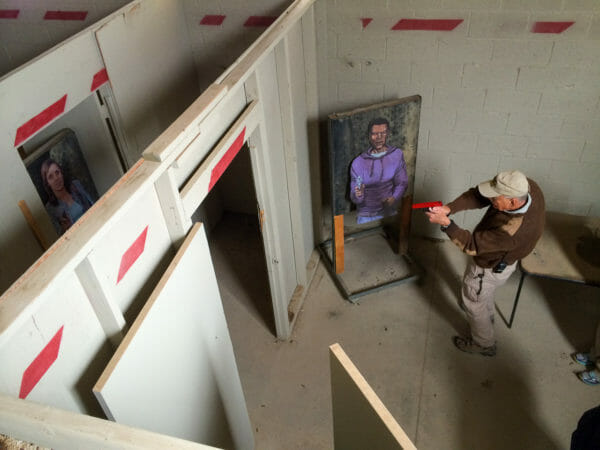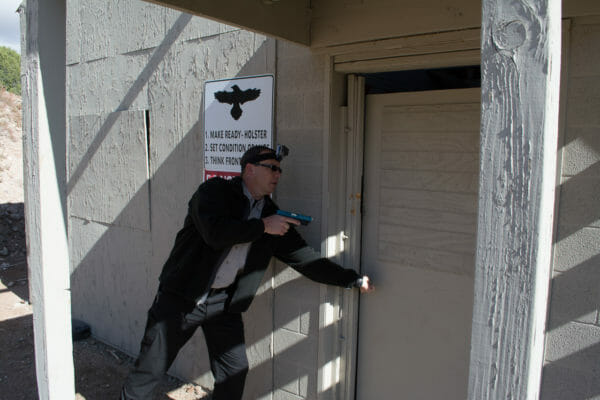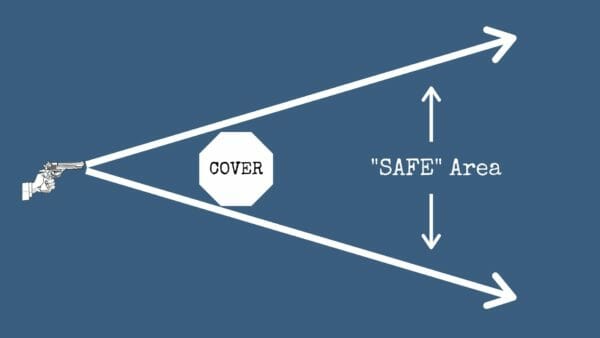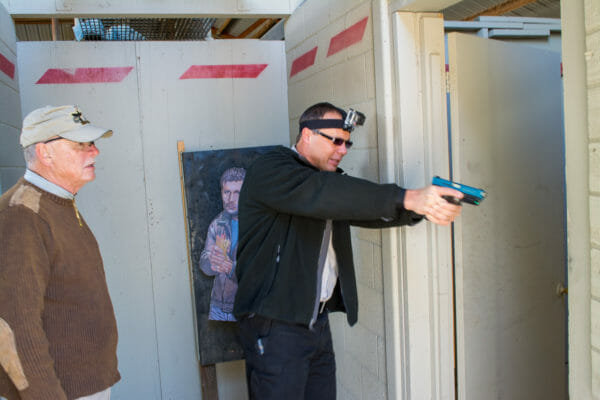
USA – -(AmmoLand.com)- One of the things that drives me crazy is the binary nature of people. I’m talking about our opinions on what the “right” answer is for any given situation.
Maybe it’s because we’re immersed in the topic, but the problem of binary thinking seems especially pervasive in the shooting and self-defense community. What do I mean by binary? The assumption that there is only one correct answer for a given circumstance and everything else is wrong. You’ve heard plenty of examples of binary discussion…
- I only train for headshots.
- Lasers are useless because they will give away your position.
- I carry on an empty chamber and will load a round quickly when I need it.
- You only need one shot if you carry a 45.
The list of controversial epiphanies like these is endless. What makes them controversial is that there’s usually a fractional nugget of truth in them. Yes, in some situations, one might need to make a head shot. However, in the vast majority of self-defense scenarios, making a headshot while both you and your attacker are amped up at top speed, moving, and trying very hard not to stand still and get shot, relying on a headshot is a pretty unrealistic objective. And yes, in some situations, a laser may “give away your position.” Does that risk outweigh the benefits of getting shots on target quickly, in low light, and from unconventional shooting positions? You get the idea. There’s seldom one correct and incontrovertible answer to anything.
When contemplating the strategies around the use of concealment and cover, we run into similar issues. Are the “conventional wisdom” responses and tactics always correct? Let’s explore.
Use Of Concealment And Cover
Cover
According to Merriam-Webster, the key concept of “cover” is protection.
cover [cov· er | \ ˈkə-vər]
verb
- to afford protection or security to
- to afford protection against or compensation
The word is protection, as in the active sense. Cover in this context means an object or natural structure that stands between you and an incoming round. By definition, it must be capable of preventing a bullet from getting to you and inflicting harm.

Examples of cover might include:
- Stone, brick, or concrete walls
- Car engine blocks
- Trees
- Marble mausoleums (Hey, you never know when you might encounter a psychotic killer in a graveyard – it happens in horror movies all the time.)
You get the idea. While there’s no universal rule of which materials will always stop a bullet, we’re talking about big, heavy, solid things with a high probability of physically protecting you from harm.
As for cover tactics, the conventional wisdom teaches a couple of core principles.
Rather than pushing up close to a cover object, one is usually better served to take a step or two back. There are several good reasons for this tactic. First, you are distancing yourself from shrapnel created by impacting bullet fragments and/or pieces of your cover object. If you stand right up against the corner of a brick building while someone is shooting at you, shards of brick, lead, and copper jackets are going to be all over your business. The other benefit of creating some space between you and your cover object is geometric in nature. By definition, the object will stop a bullet. The nifty geometry principle is that you’ll create more safe space the farther you move from the cover object. A picture is worth a few billion words, so consider this drawing.

Certainly, there’s a point where the strategy becomes ridiculous and untenable, but you get the idea. A step or two back buys you some (relatively) safe maneuvering room.
Another cover tactic is to use the pie slice method if and when you need to move forward. The classic example is moving into a room. If that undesirable activity is something you need to do, the conventional wisdom states that you should use the cover provided by the doorway to shield your body while you methodically view and clear thin slices of the room’s interior. If you have plenty of time, it’s a sound strategy.
Standard use of cover tactics are proven and often your best bet, but not always. And therein lies the danger of binary thinking. Every defensive encounter is an absolutely unique situation, and while standard principles may apply, it’s up to you to think and use your head to pull the right tactical response from your mental arsenal.
Consider some “what ifs” that may call for an alternation of conventional wisdom tactics.
Are you playing offense or defense? Since we’re talking about self and home defense, our overarching objective is always defensive, but sometimes the best or only way to defend yourself or your loved ones is to go on full-bore offense.
What if your threat is showing a small sliver of target area or is far farther than a couple of yards away? Are you better off retreating from your cover object and shooting freehand? Or are you better off crowding your cover and using it as a brace to get an accurate shot off first? Are you risking getting hit by a bullet or fragment? Yes. Are you theoretically able to get an accurate shot off before the threat accomplishes that? Also yes. So, the correct response depends.

What if you don’t have the luxury of time to follow the standard pie slice routine? Certainly, that’s always a safer strategy for you, but what if an attacker is actively harming someone inside a room or building? If you take 30 or 60 seconds to visually clear segments of the room, that’s an eternity to the victim inside. Maybe in a case like that you’re better off going on full offense and charging, relying on surprise and firepower to prevail.
Concealment
Concealment is just what it says. If you head over to Dictionary.com, you’ll find the following.
Concealment [ kuh n-seel-muh nt ]
noun
- the act of concealing.
- the state of being concealed.
- a means or place of hiding.
For our purposes, I’ll place the emphasis on the third bullet point—a means of hiding. Note that concealment says nothing about protection. In the self-defense world, some variable degree of “protection” is assumed by the act of hiding. If an aggressor can’t see you, it’s much harder for that person to harm you. In fact, they may not even be aware of your presence.
To drill down into the important distinction between concealment and cover, it’s important to note that while cover also can provide a means of hiding (concealment), its primary differentiator is that it provides a physical barrier protection while concealment does not. Just because you are hidden behind concealment, you aren’t protected from bullets. By definition, projectiles can still harm you if you are behind concealment.
Examples of concealment in the personal protection universe can be…
- Interior walls
- Doors
- Furniture
- Store shelves
- A table in a restaurant
- A seat in a movie theater
- Part of an automobile (although some parts can serve as cover also)
The good thing about concealment is that it helps to hide your location, so an attacker doesn’t know where to shoot. The rotten thing about concealment is that if the attacker is clever, they can shoot right through it.
Which leads us to a couple of interesting examples. Over the years, I’ve watched multiple videos of gunfights captured on CCTV in convenience stores and such. A fascinating observation is that when a target ducks out of sight, the shooter (good guy or bad) almost always stops firing. I suspect it’s an interesting brain that tells the primal you that shooting won’t work unless you can see the target, even if you know exactly where that target is. I specifically recall one video where two men were shooting at each other from adjacent aisles in a convenience store. When one or both ducked down, they were literally separated by a few bags of potato chips. Yet, every time, both stopped firing when their target dropped 12 inches lower and out of sight. This video clip shows a partial version of that scenario, although it’s more chaotic.
Note how action virtually stops when the men involved duck down a few inches. Sure, it’s easy to armchair quarterback and say “Well, if I were there, I would have shot them right through the groceries!” Would most people have really done that? No, probably not, especially if they hadn’t considered or training in such a scenario. If you’re intellectually honest about it, it’s easy to see how normal brain programming would lead to a “stop shooting” response when even something flimsy was between you and your target. It’s unnatural and defies our default programming.
In a slightly contrasting situation, note the pawn shop employee in this next video. When things get crazy in this situation, he seems to have few qualms about shooting through things.
While the store employee drops out of view at the critical moment, it appears that he dropped to a knee and shot right through his display case to stop the attacker. You can’t argue with the results of his strategy.
Why the difference between the two scenarios? Training might be the easy answer. The store employee in the second video sure looked like a man on a mission. He made a bold decision and put his plan into action with a double helping of commitment, obstacles, or no obstacles.
Just to be clear, we’re in no way, shape, or form advocating the Joe Biden school of self-defense where it’s OK to shoot indiscriminately through objects, not knowing what’s on the other side. In both of the cases shown here, it was clear where everyone was although the store clerk in the first video is lucky he didn’t hit the bystander as he shot aimlessly over the shelves at the end of the segment.
I share these thoughts to inspire some thinking and reflection. There’s rarely a one-answer fits every situation solution to anything, especially a dynamic self-defense encounter. It’s up to you to consider variables like these and train accordingly. At the very least, spend some time thinking through issues like these, so your brain will at least be familiar with unconventional options should the need arise.
About
Tom McHale is the author of the Practical Guides book series that guides new and experienced shooters alike in a fun, approachable, and practical way. His books are available in print and eBook format on Amazon. You can also find him on Facebook, Twitter, Instagram, and Pinterest.
